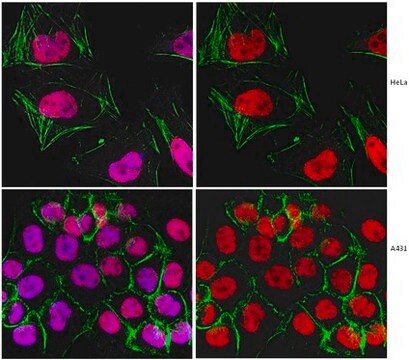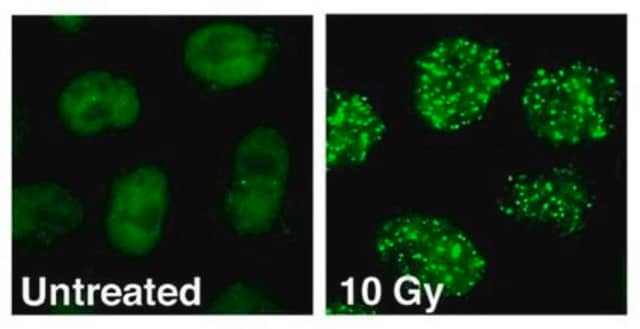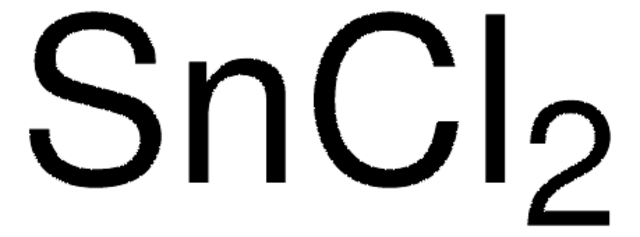17-10250
ChIPAb+ Dimethyl-Histone H4 (Arg3) Symmetric - ChIP Validated Antibody and Primer Set
from rabbit, purified by affinity chromatography
Sinonimo/i:
Histone H4
Autenticatiper visualizzare i prezzi riservati alla tua organizzazione & contrattuali
About This Item
Codice UNSPSC:
12352203
eCl@ss:
32160702
NACRES:
NA.41
Prodotti consigliati
Origine biologica
rabbit
Livello qualitativo
Clone
polyclonal
Purificato mediante
affinity chromatography
Reattività contro le specie
rat, human, mouse
Produttore/marchio commerciale
ChIPAb+
Upstate®
tecniche
ChIP: suitable
dot blot: suitable
western blot: suitable
N° accesso NCBI
N° accesso UniProt
Condizioni di spedizione
dry ice
Categorie correlate
Descrizione generale
All ChIPAb+ antibodies are individually validated for chromatin precipitation, every lot, every time. Each ChIPAb+ antibody set includes control primers (tested every lot by qPCR) to biologically validate your IP results in a locus-specific context. The qPCR protocol and primer sequences are provided, allowing researchers to validate ChIP protocols when using our antibody in their chromatin context. Each set also includes a negative control antibody to ensure specificity of the ChIP reaction.
The ChIPAb+ Dimethyl-Histone H4 (Arg3) Symmetric set includes the Dimethyl-Histone H4 (Arg3) Symmetric antibody, a Normal Rabbit IgG, and control primers which amplify a 110 bp region of ChIP Primers, human β-globin. The Dimethyl-Histone H4 (Arg3) Symmetric and negative controls are supplied in a scalable "per ChIP" reaction size and can be used to functionally validate the precipitation of Dimethyl-Histone H4 (Arg3) Symmetric-associated chromatin.
The ChIPAb+ Dimethyl-Histone H4 (Arg3) Symmetric set includes the Dimethyl-Histone H4 (Arg3) Symmetric antibody, a Normal Rabbit IgG, and control primers which amplify a 110 bp region of ChIP Primers, human β-globin. The Dimethyl-Histone H4 (Arg3) Symmetric and negative controls are supplied in a scalable "per ChIP" reaction size and can be used to functionally validate the precipitation of Dimethyl-Histone H4 (Arg3) Symmetric-associated chromatin.
Histones are highly conserved proteins that serve as the structural scaffold for the organization of nuclear DNA into chromatin. The four core histones, H2A, H2B, H3, and H4, assemble into an octamer (2 molecules of each). Histones are modified post-translationally by the actions of enzymes in both the nucleus and cytoplasm. These modifications, which include acetylation, phosphorylation, methylation, and ubiquitin-ation, occur predominantly on the N-terminal and C-terminal tails that extend beyond the nucleosome core particle. Arginine modifications of histones proteins are mediated by two classes of protein arginine methyltransferases (PRMTs), class I and II. Class I PRMTs place two methyl groups on the one nitrogen atom of the arginine guanidino group, resulting in an asymmetric modification. In contrast class II PRMTs place two methyl groups on two nitrogen atoms of the guanidino group producing a symmetric dimethylation. Although there are exceptions, asymmetric modifications are typically associated with transcription activation while symmetric modifications are most commonly associated with transcriptional repression.
Specificità
Broad species cross-reactivity expected based on sequence similarity.
This antibody recognizes Histone H4 symmetrically dimethylated at Arg3.
Immunogeno
Epitope: Dimethylated Arg3
KLH-conjugated linear peptide corresponding to human Histone H4 when symmetrically dimethylated at Arg3.
Applicazioni
Chromatin Immunoprecipitation:
Representative lot data.
Sonicated chromatin prepared from HeLa cells (1 X 10E6 cell equivalents per IP) were subjected to chromatin immunoprecipitation using 1 µg of either Normal rabbit IgG or 0.7 µg of Anti-Dimethyl-Histone H4 (Arg3) Symmetric and the Magna ChIP A Kit (Cat. # 17-610). Successful immunoprecipitation of Dimethyl-Histone H4 (Arg3) Symmetric associated DNA fragments was verified by qPCR using ChIP Primers, human β-globin as a positive locus, and GAPDH promoter primers (22-004) as a negative locus. (Figure 2). Data is presented as percent input of each IP sample relative to input chromatin for each amplicon and ChIP sample as indicated.
Please refer to the EZ-Magna ChIP A (Cat. # 17-408) or EZ-ChIP (Cat. # 17-371) protocol for experimental details.
Western Blot Analysis:
Representative lot data.
HeLa acid extract (Lane 1) and recombinant Histone H4 (Lane 2) were probed with Anti-Dimethyl-Histone H4 (Arg3) Symmetrical (0.1μg/mL). Proteins were visualized using a Donkey Anti-Rabbit IgG secondary antibody conjugated to HRP and a chemiluminescence detection system.
Arrow indicates Histone H4 (~13 kDa). (Figure 3).
Note: An uncharacterized band at ~58 kDa has been observed in some lysates.
Dot Blot Analysis:
Representative lot data.
Histone peptides with various modifications (see table below) were probed with Anti-Dimethyl-Histone H4 (Arg3) Symmetrical (1:2,000 dilution). Proteins were visualized using a Donkey Anti-Rabbit IgG secondary antibody conjugated to HRP and a chemiluminescence detection system. (Figure 4). See table below.
Immunocytochemistry Analysis:
Representative lot data.
Confocal fluorescent analysis of A431 and HeLa cells using Anti-Dimethyl-Histone H4 (Arg3) Symmetrical (Red). Actin filaments have been labeled with Alexa Fluor 488 dye Phalloidin (Green). Nucleus is stained with DAPI (Blue). This antibody positively stains the nucleus. (Figure 5).
Representative lot data.
Sonicated chromatin prepared from HeLa cells (1 X 10E6 cell equivalents per IP) were subjected to chromatin immunoprecipitation using 1 µg of either Normal rabbit IgG or 0.7 µg of Anti-Dimethyl-Histone H4 (Arg3) Symmetric and the Magna ChIP A Kit (Cat. # 17-610). Successful immunoprecipitation of Dimethyl-Histone H4 (Arg3) Symmetric associated DNA fragments was verified by qPCR using ChIP Primers, human β-globin as a positive locus, and GAPDH promoter primers (22-004) as a negative locus. (Figure 2). Data is presented as percent input of each IP sample relative to input chromatin for each amplicon and ChIP sample as indicated.
Please refer to the EZ-Magna ChIP A (Cat. # 17-408) or EZ-ChIP (Cat. # 17-371) protocol for experimental details.
Western Blot Analysis:
Representative lot data.
HeLa acid extract (Lane 1) and recombinant Histone H4 (Lane 2) were probed with Anti-Dimethyl-Histone H4 (Arg3) Symmetrical (0.1μg/mL). Proteins were visualized using a Donkey Anti-Rabbit IgG secondary antibody conjugated to HRP and a chemiluminescence detection system.
Arrow indicates Histone H4 (~13 kDa). (Figure 3).
Note: An uncharacterized band at ~58 kDa has been observed in some lysates.
Dot Blot Analysis:
Representative lot data.
Histone peptides with various modifications (see table below) were probed with Anti-Dimethyl-Histone H4 (Arg3) Symmetrical (1:2,000 dilution). Proteins were visualized using a Donkey Anti-Rabbit IgG secondary antibody conjugated to HRP and a chemiluminescence detection system. (Figure 4). See table below.
Immunocytochemistry Analysis:
Representative lot data.
Confocal fluorescent analysis of A431 and HeLa cells using Anti-Dimethyl-Histone H4 (Arg3) Symmetrical (Red). Actin filaments have been labeled with Alexa Fluor 488 dye Phalloidin (Green). Nucleus is stained with DAPI (Blue). This antibody positively stains the nucleus. (Figure 5).
Research Category
Epigenetics & Nuclear Function
Epigenetics & Nuclear Function
Research Sub Category
Histones
Histones
This ChIPAb+ Dimethyl-Histone H4 (Arg3) Symmetric -ChIP Validated Antibody & Primer Set conveniently includes the antibody & the specific control PCR primers.
Confezionamento
25 assays per set. Recommended use: 0.7 μg of antibody per chromatin immunoprecipitation (dependent upon biological context).
Qualità
Chromatin Immunoprecipitation:
Representative lot data.
Sonicated chromatin prepared from HeLa cells (1 X 10E6 cell equivalents per IP) were subjected to chromatin immunoprecipitation using 1 µg of either Normal Rabbit IgG, or 0.7 µg of Anti-Dimethyl-Histone H4 (Arg3) Symmetric and the Magna ChIP® A Kit (Cat. # 17-610). Successful immunoprecipitation of Dimethyl-Histone H4 (Arg3) Symmetric associated DNA fragments was verified by qPCR using ChIP Primers, human β-globin (Figure 1).
Please refer to the EZ-Magna ChIP A (Cat. # 17-408) or EZ-ChIP (Cat. # 17-371) protocol for experimental details.
Representative lot data.
Sonicated chromatin prepared from HeLa cells (1 X 10E6 cell equivalents per IP) were subjected to chromatin immunoprecipitation using 1 µg of either Normal Rabbit IgG, or 0.7 µg of Anti-Dimethyl-Histone H4 (Arg3) Symmetric and the Magna ChIP® A Kit (Cat. # 17-610). Successful immunoprecipitation of Dimethyl-Histone H4 (Arg3) Symmetric associated DNA fragments was verified by qPCR using ChIP Primers, human β-globin (Figure 1).
Please refer to the EZ-Magna ChIP A (Cat. # 17-408) or EZ-ChIP (Cat. # 17-371) protocol for experimental details.
Descrizione del bersaglio
~13 kDa observed. Crossreacting band at ~58 kDa has been observed in some lysates.
Stato fisico
Affinity purified
Anti-Dimethyl-Histone H4 (Arg3) Symmetric (rabbit polyclonal). One vial containing 17.5 µg of purified rabbit polyclonal in buffer containing 0.1 M Tris-Glycine (pH 7.4), 150 mM NaCl with 0.05% sodium azide before the addition of glycerol to 30%. Store at -20°C.
Concentration: 0.7 µg/µL
Normal Rabbit IgG. One vial containing 125 µg of Rabbit IgG in 125 µL of storage buffer containing 0.05% sodium azide. Store at -20°C.
ChIP Primers, human β-globin. One vial containing 75 μL of 5 μM of each primer specific for the human β-globin promoter. Store at -20°C.
FOR: AGG ACA GGT ACG GCT GTC ATC
REV: TTT ATG CCC AGC CCT GGC TC
Concentration: 0.7 µg/µL
Normal Rabbit IgG. One vial containing 125 µg of Rabbit IgG in 125 µL of storage buffer containing 0.05% sodium azide. Store at -20°C.
ChIP Primers, human β-globin. One vial containing 75 μL of 5 μM of each primer specific for the human β-globin promoter. Store at -20°C.
FOR: AGG ACA GGT ACG GCT GTC ATC
REV: TTT ATG CCC AGC CCT GGC TC
Stoccaggio e stabilità
Stable for 1 year at -20°C from date of receipt. Handling Recommendations: Upon first thaw, and prior to removing the cap, centrifuge the vial and gently mix the solution. Aliquot into microcentrifuge tubes and store at -20°C. Avoid repeated freeze/thaw cycles, which may damage IgG and affect product performance.
Note: Variability in freezer temperatures below -20°C may cause glycerol containing solutions to become frozen during storage.
Note: Variability in freezer temperatures below -20°C may cause glycerol containing solutions to become frozen during storage.
Risultati analitici
Control
Includes normal rabbit IgG and primers specific for human β-globin.
Includes normal rabbit IgG and primers specific for human β-globin.
Altre note
Concentration: Please refer to the Certificate of Analysis for the lot-specific concentration.
Note legali
MAGNA CHIP is a registered trademark of Merck KGaA, Darmstadt, Germany
UPSTATE is a registered trademark of Merck KGaA, Darmstadt, Germany
Esclusione di responsabilità
Unless otherwise stated in our catalog or other company documentation accompanying the product(s), our products are intended for research use only and are not to be used for any other purpose, which includes but is not limited to, unauthorized commercial uses, in vitro diagnostic uses, ex vivo or in vivo therapeutic uses or any type of consumption or application to humans or animals.
Codice della classe di stoccaggio
10 - Combustible liquids
Certificati d'analisi (COA)
Cerca il Certificati d'analisi (COA) digitando il numero di lotto/batch corrispondente. I numeri di lotto o di batch sono stampati sull'etichetta dei prodotti dopo la parola ‘Lotto’ o ‘Batch’.
Possiedi già questo prodotto?
I documenti relativi ai prodotti acquistati recentemente sono disponibili nell’Archivio dei documenti.
Il team dei nostri ricercatori vanta grande esperienza in tutte le aree della ricerca quali Life Science, scienza dei materiali, sintesi chimica, cromatografia, discipline analitiche, ecc..
Contatta l'Assistenza Tecnica.








